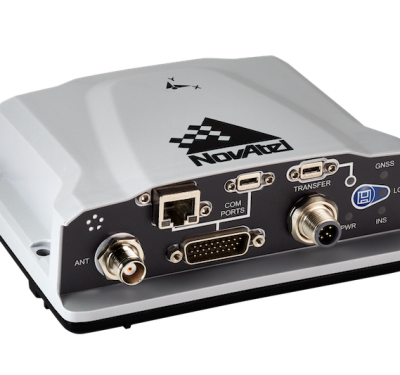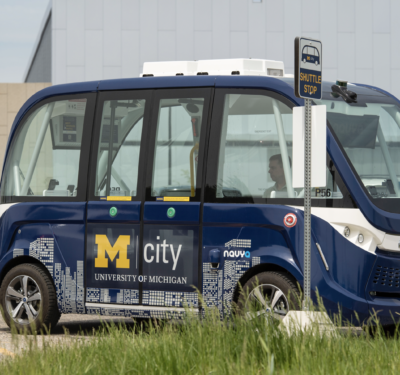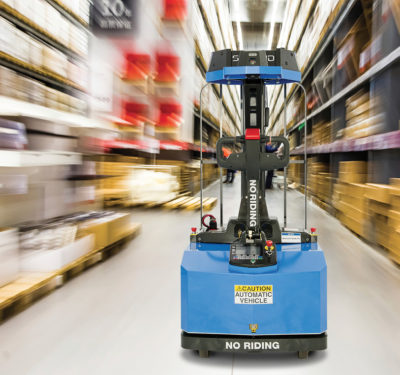
In collaboration with GreenPower, Perrone Robotics and the Jacksonville Transit Authority are setting a new precedent for the future of public transit.
Jacksonville, Florida, may be blazing new ground by commissioning an autonomous electric vehicle. Its newly acquired EV Star stands to change the paradigm of public transit, both now and into the future. The vehicle is produced by GreenPower of Rancho Cucamonga, California, and is made autonomous by Perrone Robotics of Crozet, Virginia.
“We’ve been in the autonomous space for a while,” explains Paul Perrone, founder and CEO of Perrone Robotics, which outfitted the EV Star. “In 2019, we took that vehicle to a conference in Florida. Some folks from the Jacksonville Transportation Authority [JTA] visited us and rode in the vehicle.”
While at the conference, Perrone learned about JTA’s upcoming proposals for its Ultimate Urban Circulator (U2C) program. Perrone Robotics pursued the opportunity and submitted a proposal.
“They wanted it to be Americans with Disabilities Act [ADA] compliant and be able to run on public roads and be Federal Motor Vehicle Safety Standards (FMVSS) compliant,” Perrone said. “We had been looking at a couple of different vehicles and found the EV Star.”
Perrone felt it could be fitting for the proposal. It checked all the boxes from a vehicle platform: all-electric, ADA-compliant, FMVSS-compliant. It had good Altoona testing ratings after conducting a vehicle survey. Perrone won the award.
Bernard Schmidt is the vice president of automation and innovation for the JTA. “The EV Star is a paratransit vehicle,” Schmidt noted. “Its current purpose and use reside within the JTA’s Test and Learn program. It provides critical R&D information relative to environmental sustainably and our autonomous vehicle endeavors. In addition to testing, the vehicle is used in our public advocacy and STEM efforts throughout Jacksonville.”
“With Perrone, we were able to automate the vehicle,” added Brendan Riley, president and director of GreenPower. As Riley explained, the vehicle is, for practical purposes, a Level 5 autonomous vehicle, but it is considered a Level 4 because it has a steering wheel.
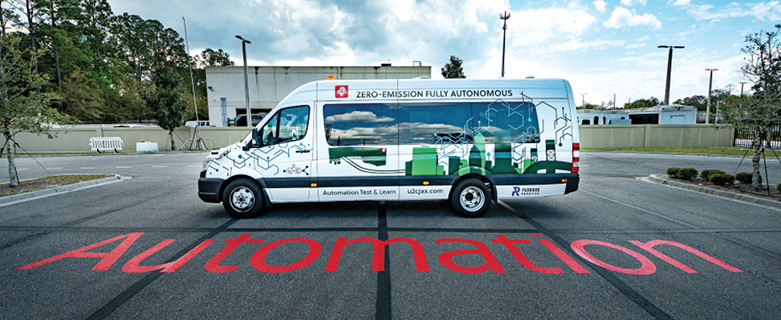
THE ART OF RETROFIT
The new vehicle exemplifies the versatility of converting ordinary vehicles to autonomous ones. The EV Star was built as an electric vehicle; with Perrone’s automation, it became autonomous.
“We have what’s called an ‘over-the-top’ solution for these types of vehicle platforms,” Perrone said. “With our kit, we mount actuators to control the steering [and] other actuators to control the brake and throttle as well as the shifting of the vehicle and any emergency braking. All that is part of our “to navigate you” (TONY) retrofit kit. Then we take the equipment boxes and sensors and install them on the vehicle. After some configuration and tuning, it’s a fully autonomous vehicle.”
Perrone added that much depends on the vehicle’s operational design domain, which determines the equipment to deploy. In this case, the vehicle would have a steering wheel and an operator on standby to grab the wheel if necessary. This same person is present to assist in anything else necessary in the operation of the vehicle. “In the cases of Jacksonville and the environment in which they’re operating, they have a safety operator on board,” Perrone noted. “They’re there to start the mission. At any point, they can press a button and take control, and it drives just like you drove it off the lot.” Perrone clarified that with another press of a button, it then reverts from manual back to autonomous.
The vehicle was built as a class four vehicle—a category determined by the gross vehicle weight rating. Its vehicle is the only purpose-built class four vehicle that isn’t a converted van. “We didn’t buy a Dodge ProMaster or a Sprinter, remove the engine and that stuff, and put in our stuff,” he said. “We make the body. We start out with just a shell and put in the motor and the battery. It’s all designed, from day one, to be an EV. That’s one differentiator from us and any other vehicle manufacturer. Most of the other ones that I know are converted Fords, Dodges or GMs.”
Perrone heralded the company’s technology as an important part of its ability to convert the EV Star, or any other vehicle. It is vehicle-propulsion-agnostic.
“Because of this over-the-top solution, anything that has a steering wheel, brake and throttle [which is pretty much every vehicle] we can control,” Perrone said. “We’ve done gas, electric and diesel vehicles. We’ve done large mining trucks. We’re doing yard trucks that pick up semitrailers and move them from point A to point B in a yard. We’ve done small electric vehicles and regular gas-powered vehicles. We worked with Jaguar Land Rover for several years, automating some SUVs of theirs. So, it’s agnostic across vehicle platform types. We’ve also expanded into articulated trailers—where you must plan the path a little differently because you’ve got these long trailers, and they’ve got to take turns.”
Perrone added that the company’s software stack is proprietary. It owns a patent for it that dates back to about 2006: the General-Purpose Robotics Operating System. “It’s the software that is really the virtual driver that’s in there while sensing what’s around it,” he explained. “It figures out when to maneuver and engage. The software is programmed with intelligence that responds to questions like, ‘Am I pacing a vehicle? Am I avoiding a pedestrian now? Am I making a U-turn?’ It then controls the steering, brake and the throttle speed of the vehicle. All that software is created by us. And we call it MAX, Mobile Autonomous X.”
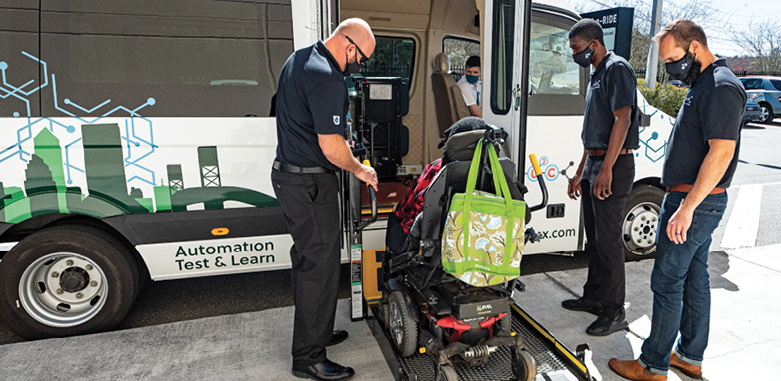
IDEAL FOR MUNICIPAL TRANSIT APPLICATIONS
The Level 4 autonomous EV Star represents a solution sought by many municipalities seeking ways to better outfit their fleets. It provides not only an environmentally friendly solution but also one that is economical and efficient, and that contributes to passenger safety. The operator on board may serve other roles besides being a standby driver and boosts transit riders’ customer experience.
The vehicle itself doesn’t pose great challenges in terms of charging or its range—both are manageable with the EV Star’s configuration.
Specifically, the vehicle offers significant versatility in charging, which makes it ideal for a transit application. “It can be charged using three different types of charging,” Riley noted. “It uses Level 2 charging with easy Level 2 chargers that are everywhere. It can charge in about eight hours using a Level 2 charger. Then it has a DC fast charger (standard) that charges a vehicle in about two hours. We also have another form of charging: wireless charging. If you buy the vehicle with the wireless charging option, it drives over a pad and can charge in about an hour and a half, from zero state of charge all the way up to 100%, wirelessly.”
Often, acceptance of any electric vehicle prompts the question of the vehicle’s range: Can the vehicle fulfill its mission on a single charge, especially for transit applications? Riley said that in most cases, it can.
“Let’s say the vehicle’s parked for a long period of time,” he explained. “It’s got the heater or the air conditioning running. You might not be able to go the full 150 miles if you do a lot of that. But typically, if you’re stopped, you’re using less power. Driving uses the most power. It usually works out where you can do a whole day in the bus application. Buses rarely go 150 miles a day running in inner city routes. That’s 10 miles an hour for 15 hours, or 15 miles an hour for 10 hours. Typically, buses out in the field run for eight hours, with an average speed of between 15 and 18 miles an hour. So, it usually meets most of the requirements of a bus route. You must average all the stops and everything with it.”
Some question the presence of a standby operator onboard and may view that operator as extraneous. However, that person may be an added plus.
“With regards to the replacement of real human people [as drivers] with autonomous capability in the transit space, I think what’s going to happen, certainly initially, is that you’re still going to have an operator on board,” Perrone added. “In transit, people sometimes need help getting on and off the vehicle. If someone has a medical issue or condition, you’re going to want to have somebody there. But the driver becomes more like a concierge or a service provider. They might sit in the back of the vehicle as it becomes truly driverless. But I think you’ll still have a person there in transit for a little while for those reasons.”
Because autonomous vehicles are new, are different, and raise questions in the minds of many, it’s often difficult to gain public acceptance of them. “The public acceptance is part of the process,” Schmidt noted. “We recognize we must do our part to educate our customers and the general public. The data speaks for itself from many of our demonstration surveys that more than 95% of people who ride and participate on one of our static or dynamic displays react favorably after the experience.”
NOT IF—WHEN
The arrival of the EV Star and its adoption by the JTA may well be at the vanguard of what is to come for the future of public transit. Transit fleets are not only fertile ground to implement sustainable, economical and efficient technology but also an environment dedicated to safety. As Perrone explained, the genesis of the EV Star for JTA is addressing a need. “I think that the path for us, and I think the path for [the] industry, really, is to start with these defined zone applications that you can do safely and reliably now,” he continued. “I think a lot of companies are way too far over their skis and are exploring things like artificial learning and deep learning and neural networks—which they can’t even prove are safe. You want to know it works.
“Starting out in these defined zone applications is exactly where we’re going to prove that autonomy works and gives the return on investment that folks have been expecting and wanting,” Perrone added. “It may not be as glamorous as what was hyped 10 years ago, but it’s going to work. And it’s going to work well, and it’s going to save jobs, and it’s going to save lives. Operations will become more complicated, and you’ll be able to do things like long-haul trucking. I always applied the litmus test of, ‘Would I put my child or myself in this vehicle? And would I want my child or myself to be in a vehicle that’s next to one of these vehicles?’ If the answer is no, it’s probably a little bit further out there.”
Public transportation and municipal fleets are commonly a proving ground for new technology. That is very true for the advent of autonomous vehicles. Once developed, and implemented, an electric autonomous vehicle, which has already been tested and ready to serve the public, becomes a proof-of-concept in the public eye.
The JTA is moving forward with autonomous vehicle technology. “Based on our vision for the Ultimate Urban Circulator or U2C autonomous vehicle program, the JTA made a decision to retrofit this vehicle with an autonomous kit by Perrone Robotics,” Schmidt stated. “The purpose is in line with our Test and Learn Program approach to better understand all our autonomous vehicle options. More importantly, as the JTA progresses toward multiphase implementation of the U2C, the EV Star provides us an already approved and fully ‘street-legal’ vehicle with autonomous capability as an option to consider for the U2C. The JTA is constantly looking to advance its sustainability posture. The EV Star and AVs overall play a big role. To quote our CEO, Mr. Ford, ‘We see electric and autonomous vehicle technology not being a matter of if, but a matter of when.’”


